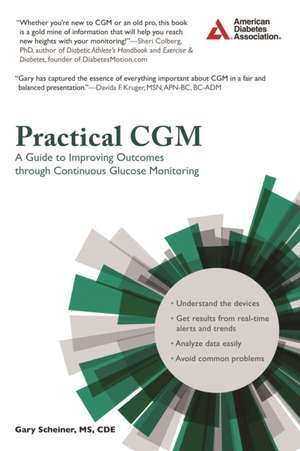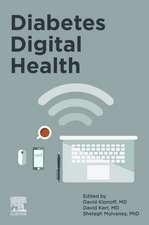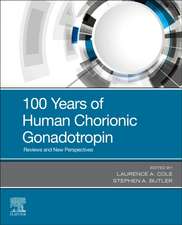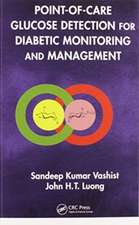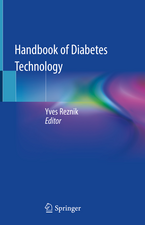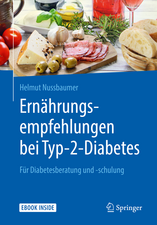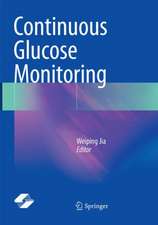Practical Cgm: Improving Patient Outcomes Through Continuous Glucose Monitoring
Autor Gary Scheineren Limba Engleză Paperback – 10 aug 2015
Use of real-time continuous glucose monitors among people with type 1 and type 2 diabetes is growing rapidly and should continue to grow until an artificial pancreas is brought to market. Likewise, use of professional systems in healthcare practices is expanding. But, other than manufacturer instructional manuals and some book chapters on CGMs, there are no standalone publications available with concise, non-commercial instructions on CGM prescription and use.
Additionally, continuous glucose monitors are too often not used to their full and proper potential. This leaves users with suboptimal glucose control and can result in system abandonment.
To address this, diabetes educator and author Gary Scheiner has created Practical CGM: Improving Patient Outcomes through Continuous Glucose Monitoring to give healthcare providers the skill to make more effective use of the data generated by continuous glucose monitors, in both real-time and on a retrospective analytic basis. Using a plain-language approach and distilling content to concise, practical tips and techniques, Scheiner has created a guide that will help practitioners optimize patient use of CGM systems and, ultimately, improve glucose control and patient health outcomes.
Additionally, continuous glucose monitors are too often not used to their full and proper potential. This leaves users with suboptimal glucose control and can result in system abandonment.
To address this, diabetes educator and author Gary Scheiner has created Practical CGM: Improving Patient Outcomes through Continuous Glucose Monitoring to give healthcare providers the skill to make more effective use of the data generated by continuous glucose monitors, in both real-time and on a retrospective analytic basis. Using a plain-language approach and distilling content to concise, practical tips and techniques, Scheiner has created a guide that will help practitioners optimize patient use of CGM systems and, ultimately, improve glucose control and patient health outcomes.
Preț: 89.39 lei
Preț vechi: 94.09 lei
-5% Nou
Puncte Express: 134
Preț estimativ în valută:
17.10€ • 17.91$ • 14.15£
17.10€ • 17.91$ • 14.15£
Carte disponibilă
Livrare economică 15-29 martie
Livrare express 01-07 martie pentru 17.98 lei
Preluare comenzi: 021 569.72.76
Specificații
ISBN-13: 9781580406031
ISBN-10: 1580406033
Pagini: 72
Dimensiuni: 147 x 226 x 10 mm
Greutate: 0.2 kg
Ediția:4
Editura: American Diabetes Association
ISBN-10: 1580406033
Pagini: 72
Dimensiuni: 147 x 226 x 10 mm
Greutate: 0.2 kg
Ediția:4
Editura: American Diabetes Association
Notă biografică
Gary Scheiner, MS, CDE (the owner and clinical director of Integrated Diabetes Services LLC in Wynnewood, PA), is a well-known expert in the field of diabetes care and education. Gary’s approach to diabetes education earned him the 2014 Diabetes Educator of the Year Award from the American Association of Diabetes Educators. He has written a number of books for people with diabetes and healthcare professionals, including the best-selling and highly acclaimed Think Like a Pancreas: A Practical Guide to Managing Diabetes with Insulin.
His expertise in Continuous Glucose Monitoring is extensive. He serves on the clinical advisory boards for multiple CGM device manufacturers and has written several articles for consumer magazines and chapters for textbooks on the subject. He has lectured internationally to both lay and professional audiences on continuous glucose monitoring and has trained and educated more than 500 clients on the use of all types of commercially-available CGM systems. Gary has used CGM in the management of his own diabetes since its advent in the 1990s.
His expertise in Continuous Glucose Monitoring is extensive. He serves on the clinical advisory boards for multiple CGM device manufacturers and has written several articles for consumer magazines and chapters for textbooks on the subject. He has lectured internationally to both lay and professional audiences on continuous glucose monitoring and has trained and educated more than 500 clients on the use of all types of commercially-available CGM systems. Gary has used CGM in the management of his own diabetes since its advent in the 1990s.
Descriere
Use of real-time continuous glucose monitors among people with type 1 and type 2 diabetes is growing rapidly and should continue to grow until an artificial pancreas is brought to market. Likewise, use of professional systems in healthcare practices is expanding. But, other than manufacturer instructional manuals and some book chapters on CGMs, there are no standalone publications available with concise, non-commercial instructions on CGM prescription and use.
Additionally, continuous glucose monitors are too often not used to their full and proper potential. This leaves users with suboptimal glucose control and can result in system abandonment.
To address this, diabetes educator and author Gary Scheiner has created Practical CGM: Improving Patient Outcomes through Continuous Glucose Monitoring to give healthcare providers the skill to make more effective use of the data generated by continuous glucose monitors, in both real-time and on a retrospective analytic basis. Using a plain-language approach and distilling content to concise, practical tips and techniques, Scheiner has created a guide that will help practitioners optimize patient use of CGM systems and, ultimately, improve glucose control and patient health outcomes.
Additionally, continuous glucose monitors are too often not used to their full and proper potential. This leaves users with suboptimal glucose control and can result in system abandonment.
To address this, diabetes educator and author Gary Scheiner has created Practical CGM: Improving Patient Outcomes through Continuous Glucose Monitoring to give healthcare providers the skill to make more effective use of the data generated by continuous glucose monitors, in both real-time and on a retrospective analytic basis. Using a plain-language approach and distilling content to concise, practical tips and techniques, Scheiner has created a guide that will help practitioners optimize patient use of CGM systems and, ultimately, improve glucose control and patient health outcomes.
